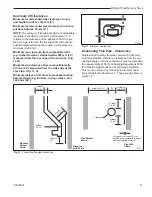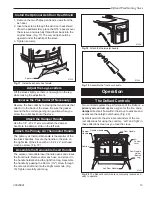
25
Defiant Woodburning Stove
30003841
T
he Catalytic Element
This wood heater contains a catalytic combustor, which
needs periodic inspection and replacement for proper
operation. In the United States it is against the law to
operate this wood heater in a manner inconsistent with
the operating instructions in this manual, or if the cata-
lytic element is deactivated or removed.
Under normal operating conditions, the catalytic com-
bustor should remain active for two to six years (de-
pending on the amount of wood burned). However, it
is important to monitor the combustor periodically to
ensure that it is functioning properly, as well as to de-
termine when it needs to be replaced. A non-functioning
combustor will result in a loss of heating efficiency, and
an increase in creosote and emissions.
Inspection and Cleaning
Inspect the combustor “in place” for fly ash accumula-
tion and physical damage three times per year. Clean
the combustor as needed. Do not remove the com-
bustor unless a more detailed inspection is warranted
because of diminished performance as outlined in the
next section.
The refractory package that houses the catalytic com-
bustor should be inspected annually for a buildup of fly
ash and cleaned if necessary. This may be done when
you examine the combustor.
When to Suspect a Combustor Problem
The best way to evaluate the performance of your
Defiant’s combustor is to observe the amount of smoke
leaving the chimney — both when the combustor has
“lighted-off” and when it has not. Follow these steps:
•
With a fire going and the combustor properly activat-
ed, with the damper closed to route smoke through
it as described in the Operation Section, go outside
and observe the smoke leaving the chimney.
•
Then, open the stove damper and once again check
the smoke leaving the chimney.
You should see significantly more smoke when the
stove damper is open and exhaust does not pass
through the combustor. However, be careful not to
confuse smoke with steam from wet wood. Steam dis-
sipates in the air quickly; smoke does not.
If this test indicates a problem, consider other possible
factors as well, such as the weather or a change in the
quality of your fuel. In warm weather, draft is weaker
than it is in colder winter weather, and fires can burn
sluggishly. Small, hot fires are a good solution under
these conditions.
Burning “green” (insufficiently seasoned) wood will
result in poorer performance than burning properly
seasoned fuel. You may have to run your stove hotter
(more air) to achieve acceptable performance using
green or wet wood.
Also, consider any changes in your operating routine.
Once you have ruled out any other possible causes for
a decline in performance, inspect and clean the com-
bustor if necessary. Be sure to protect any surface you
use for setting the stove parts aside.
Inspecting the Combustor
1. Lift the throat off its support brackets, and then
remove it from the stove and place it on a protected
surface. (Fig. 35)
2. Use a flashlight, and a mirror if necessary, to exam-
ine the combustor. If no fly ash or damage is visible,
the inspection is complete and you may replace the
baffle. If closer examination or cleaning is needed,
go to the next section.
ST555
Inspect
Catalytic element
11/00
Baffle Support
Brackets
Catalytic
Element
ST555
Fig. 35
Lift the baffle off its supports to inspect the catlyst.
Removing and Cleaning the Combustor
1. Remove the firebricks. Lift off the steel clip and
remove the bricks individually. (Fig. 36)
2. Tap the left and right wedges upward, and remove
the lower fireback by pulling it forward. You can
either let it lie face down on the firebox floor, or re-
move it from the stove, through the front door open-
ing. (Fig. 37)
Содержание Defiant 1945CE
Страница 34: ...34 Defiant Woodburning Stove 30003841...












































